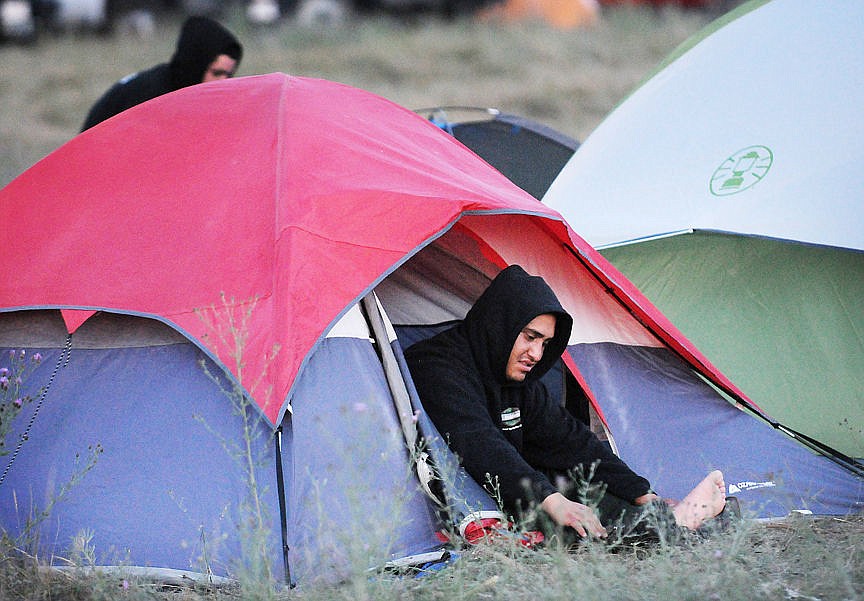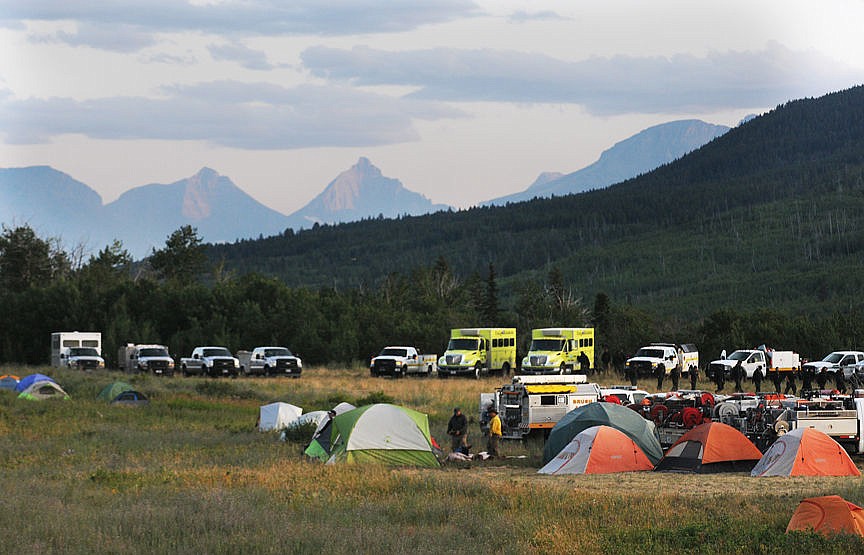FIRE CAMP: 'You have everything... you need'
ST. MARY — At 7 p.m. each evening, the Chewing Blackbones Campground, hugging the northeastern shore of Lower St. Mary Lake, springs to life as hundreds of weary, soot-covered firefighters arrive back from their 12-hour shifts on the front lines of the Reynolds Creek Fire.
Welcome to fire camp.
The blaze, which began Tuesday afternoon in Glacier National Park, about six miles east of Logan Pass, now has more than 450 men and women on site battling the flames.
That growing number of firefighters, equipment operators, officers and other personnel necessitate a sprawling complex of amenities, including sleeping and dining areas, shower units, a helicopter repair area, kitchens on wheels and centers for planning, logistics and other operations.
“It’s like a small town — you have everything here you need,” says information officer Mike Cole, adding that camps with 1,000 or more firefighters often include a commissary as well.
After returning from the fire, the first stop for most of the incoming crews is the all-important chow line. On this fire, Missoula-based Big Sky Catering provides all the meals, which even include vegetarian options. Each firefighter is fed 5,000 to 6,000 calories per day, since, as Cole notes, “If you don’t have the calories, you can’t do the work.”
By 9 p.m. on Friday night, the bustle around Big Sky’s portable kitchen is finally dying down, and hand crew member Adam Staniszewski pauses a moment from his hard-earned meal to reflect on his time since arriving at the fire Tuesday night.
“It’s a pretty sweet fire camp, actually — you can’t really beat the location,” he says. “But we don’t really spend a lot of time here. Basically, you just wake up, eat, go out, and you’re getting back in time to eat again and go to bed.”
This is his first year working for the Flathead National Forest’s Swan Lake Ranger District, and although it’s his third fire, he says he’s never worked on one of this magnitude before.
“It’s a very complex fire, and there’s a lot of people here filling different roles,” he says. “Glacier Park is my favorite place in the world, and working with other people on the ground, trying to minimize the damage to the resources here is a really cool experience.”
JAY WOOD is the supervisor for the Bitterroot Hotshots out of Darby, one of a half-dozen elite, 20-person ground crews tackling the most volatile parts of the fire. They’ve spent the day between St. Mary River and the St. Mary Trail, cutting down snags and timber, clearing brush and digging down to the inflammable, mineral soil to add to the slow-growing containment line.
Adding to the difficulty of building fire lines in the rugged, heavily timbered terrain is the political sensitivity of the location.
“One of the challenges is that, being in the park, it’s a highly political thing,” the ash-streaked crew leader explains. “We recognize that we’re in the park, and we’re trying to do minimal resource damage.”
He describes his team as a big family, with seven core members who have worked with him for years, and the remainder drawn from a large pool of on-call firefighters hoping to earn one of the coveted permanent positions on a crew.
“They’re Type-A people, they want to be busy and don’t want to be stagnant or stationary,” he says. “A little bit of it is that they’re adrenaline junkies, they like the rush... and it’s that kind of nomadic lifestyle, getting to travel all around the country.”
BEFORE THE evening influx of firefighters arrives, the sprawling camp resembles a ghost town — dozens of empty camping tents rustle in the breeze on the south side of the site, and a few firefighters, officers and planning and mapping experts wander in and out of several yurts in which different incident team sections are housed. Each has been erected for a separate functions; one for officers, one for new crews checking in and others for the planning, logistics, finances and mapping sections.
Across from the dining area, a pair of semis sits with two trailers converted into shower units — one for men and the other for women. A line of sinks and mirrors are set up next door. Aside from the obvious dangers inherent in fighting fires, the men and women at the camp are also more susceptible to catching cold, with long hours and extreme conditions taking a toll on their immune systems.
“Hygiene is a huge issue here,” explains Cole, adding that “camp crud” is the catch-all term for illnesses spreading through the ranks. “If people start getting sick, we send them home.”
FRIDAY AFTERNOON, with scores of firefighters engaged in various jobs to get a handle on the more than 3,000 acres of actively burning fire, about six dozen mapping and Geographic Information Systems specialists occupy the “map room.” In just the past few years, this aspect of high-level fire management has changed dramatically.
Crew leaders on the ground carry iPads connected to a local network, providing the technicians at the base with live updates on spot fires, slop-overs, resource needs and any other changing conditions. In the middle of the tent, a projector shines a map of the area on the back wall, displaying the portion of the park in which the fire is still active and continually updating with new information provided by the ground crews.
“It’s going out to the ‘cloud’ every six or seven seconds to grab more information,” explains GIS specialist Mark Slaten, who also works as the state’s regional inventory forester in Kalispell.
He explains that the black circles designate drop points, to which crew leaders can direct helicopters to deliver water, hoses, pumps, fresh hand tools, lunches and any other needed materials. The screen refreshes again, and a green line appears northeast of the fire’s front, marking the place where a specialized planning team has just designated a “management action point.” Should the fire cross that line, the team will implement a range of actions, potentially including evacuations.
“When it reaches a certain location, you want to do something to stay ahead of the fire strategically,” adds Cole. “That was their job today in that division, to come up with a contingency plan.”
DOWN A dirt road leading from the entrance to the camp, mechanics man a helicopter landing area, where the continually flying aircraft are parked for periodic maintenance and repairs. Like the pilots, the choppers are limited to a certain number of hours of operation every 24-hour period, and maintenance is required after a set number of hours in the air.
On Saturday, seven helicopters were assigned to the blaze, dumping up to 2,400 gallons at a time on spot fires along the advancing northeast front while smaller helicopters helped cool down the back side of the blaze, where hotshot and hand crews were working to establish containment.
The substantial aerial support doesn’t come cheap.
“This is a big air show — we’ll have a lot of air expenses on this fire,” Cole says.
That’s just one component of the suppression effort’s price tag, which typically averages around $750,000 per day for a Type I team such as the one now in charge in St. Mary.
As of July 24, the most recent date the information was available, the total cost of the firefighting effort was $1.7 million. Ask anyone on the ground fighting the fire, trying to preserve a large portion of Glacier National Park, and they will tell you it is worth it.
Reporter Samuel Wilson can be reached at 758-4407 or by email at swilson@dailyinterlake.com.








